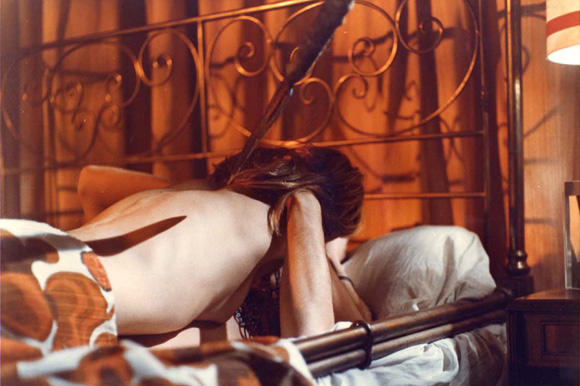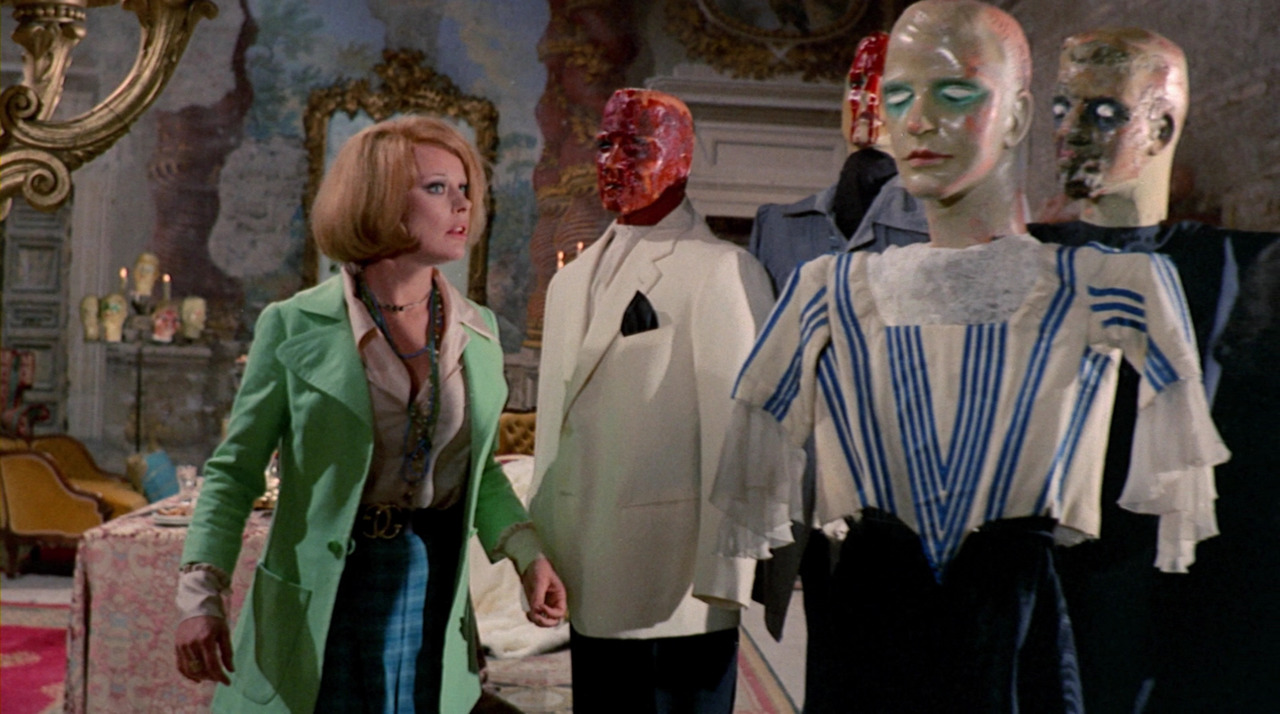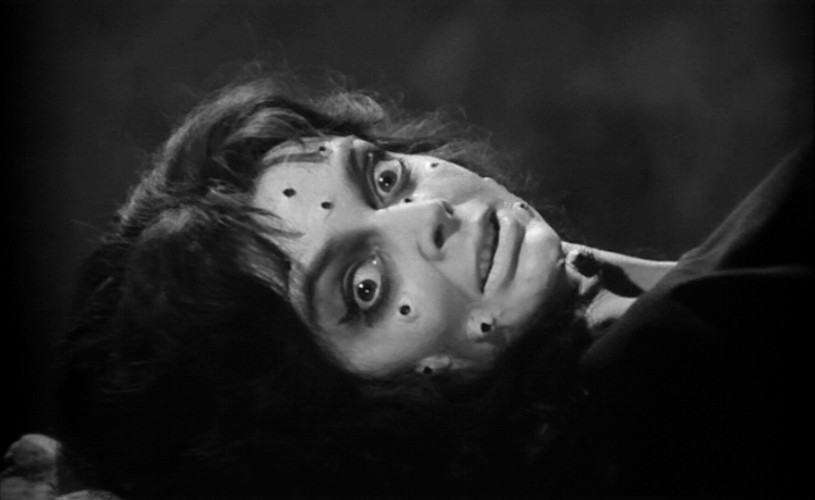5. Twitch of the Death Nerve aka Bay of Blood (1971)
The Story:
This rather Byzantine tale revolves around the efforts of several people to gain ownership of a coveted piece of property along a bay. A countess, her husband, several oblivious teens, some of the conspirators, and other bystanders fall victim to violent murders, including but not limited to stabbings, choppings, beheadings, and stranglings. It’s a bloody race to see who can live long enough to inherit the property, and even then there is no guarantee that the survivors will be able to collect in the long run.
Why This Film Matters:
Want to know where slasher movies come from? Here you go: the soil out of which that particular homicidal seed flourished. There’s no masked killer out to dispatch oversexed youngsters because of a misguided sense of social conservatism, but the basic blueprint is right there. People are knocked off one by one, in savage fashion, the fairly complicated murder mystery plot being nothing more than a clothesline to hang each spectacular killing on.
Bava pushed the giallo into overdrive here, and it wasn’t long before Dario Argento would take the wheel and drive it even further into the red. And don’t think for a second that I’m leaving out the American part of the equation: Sean Cunningham’s Friday the 13th draws heavily from this film, placing its story in a setting very similar to the bay in Bava’s picture, and using the same “bump people off one at a time” rhythm.
Friday the 13th Part 2 one-upped its predecessor by borrowing two of Death Nerve’s more memorable killings, most memorably two lovers being nailed to a bed with a spear as they have sex. People can argue that Halloween and Psycho had as much of an influence on the slasher genre as this, but the essential template used throughout the 1980’s started here. Unfortunately, much of the clever social commentary got left behind by its imitators.
You get the impression that Bava thought of the human race as being just a little detestable, especially in the way he portrays people brutally killing each other for superficial material gain. Trust and fidelity are nowhere to be seen, and in the end, the evil legacy created by the characters is picked up by the next generation, however unintentionally, leading to even more death. After decades of splatter movies, its hard to imagine how shocking this film must have seemed to contemporary audiences, but even now it still has the power to startle viewers—with its cynicism if not with its violence.
4. Blood and Black Lace (1964)
The Story:
In a swanky fashion house in Italy, models are dying at the hands of a masked maniac for reasons no one can fathom. In time, it comes out that a diary kept by one of the models reveals certain dirty secrets that several people working for the company would like kept under wraps.
Whoever is committing the murders seems desperate to get their hands on the diary, considering no act too heinous (one woman even has her face burned off on a hot stove) in achieving their goal. When the killer’s identity is ultimately uncovered for the audience, it’s clear the fashion industry is a much dirtier game than anyone realized.
Why This Film Matters:
General opinion maintains that this is the starting point for every modern slasher film, as well as where the giallo first came to prominence as a crime sub-genre. While the basic plot makes it an ostensible murder mystery, the emphasis is on the colorful, stylized, and intensely violent killings. Think Federico Fellini filtered through the sensibilities of Wes Craven, or vice versa. It also wouldn’t be unreasonable to assume that the color-coordination of the killer’s disguise might have inspired that of Michael Myers in John Carpenter’s Halloween.
Bava invites us into a carnival funhouse of flashing florescent neon, fluid camera movement and mid-’60’s high-end clothing styles, all while emphasizing the theme of corruption and decay visited on the present as a result of the crimes of the past, present in much of his major work. Possibly the most successful fusion of gruesome subject matter and beautiful imagery Bava ever achieved, heavy with the kind of lushly saturated color rarely seen in horror films up to that point. The violence is realistically graphic without being overly bloody, but nevertheless put many critics off and hurt the film’s chances with overseas distributors.
3. Lisa and the Devil (1974)
The Story:
A young tourist (Elke Sommer) on a trip in Spain becomes separated from her tour group, wandering into an antique shop where she sees a man (Telly Savalas) who bears a striking resemblance to a portrait of the Devil she’s just seen in town. She also encounters another strange man who claims to know her. Desperate to find her way, she accepts a lift from a well-to-do couple and their chauffeur, who stop at a mansion outside of town when their car breaks down.
The family living in the mansion seem pretty weird indeed, not to mention secretive, and the man from town played by Savalas just happens to be their butler. Sommer continues to see the other man around the mansion, who insists that they used to be lovers. Everyone living in the mansion acts as if she ought to know them as well, and Savalas is, for some reason, keeping a roomful a mannequins upstairs, acquired from the owner of the antique store. When the chauffeur is murdered, things take a turn for the worse, and Sommer slowly realizes that she is part of a cycle of love, jealousy, betrayal and murder that has been going on in this mansion for a long time, and shows little sign of ever letting up.
Why This Film Matters:
Bava was given license to do whatever kind of film he wanted, and he made full use of that opportunity. Pretty much everything that made him Bava is on riotous display here: colors pop like a botanical garden in spring, camera movement is innovative and thrilling, and the story is easily his weirdest, coming together with a finale that would fit perfectly in the old Twilight Zone or Night Gallery. It’s his most visually dense film since Black Sunday, and while in some ways it exists as an experiment in pure cinema, he doesn’t ignore plot and character obligations, but rather employs a surrealistic technique to tell a tale of tragedy and helpless slavery to the past. James Joyce once wrote, “History is a nightmare from which I am trying to awake”, and one can’t help but think that Bava shared a similar attitude about the past.
It’s an idea that keeps cropping up in his work, but where in other films characters manage to triumph over the evils of earlier times, here all of the players are doomed to relive their ill-advised actions throughout eternity, within their own personal hell, watched over carefully by a dutiful and overworked Devil. As sad as all that sounds, a kind of gleeful, impish humor abounds, particularly through Savalas’ sinister, obsequious, and charming performance (fans of the old Kojak series will be delighted to see he enjoys suckers here as well).
It’s important to point out that I’m talking about the original Lisa and the Devil here, not the recut and reshot version that came out a year or so later. The film was a financial failure, so the producer had a demonic possession and exorcism subplot shot and cut into the film to cash in on the success of The Exorcist, giving it the title The House of Exorcism. Both versions are available on DVD. Some might find it interesting to made a comparison between the two, but it’s clear which is the better movie.
2. Black Sunday (1960)
The Story:
The witch Asa and her lover Javuto are put to death for practicing black magic, but before she dies Asa curses her executors and their descendants. Two-hundred years later, two doctors on their way to a medical conference stop in the family crypt of a local prince and, through a series of accidents, bring Asa back to life. She summons Javuto from his tomb and together they prey on the prince, his son, and his young daughter (played by Barbara Steele, who also plays Asa). It is only through the courage of the youngest doctor that finally Asa and Javuto are defeated, with Asa burned at the stake by frightened villagers intent on destroying her once and for all.
Why This Film Matters:
Bava’s first project as a credited director gives the viewer an early look at the hyper-stylized, highly Expressionistic lighting and set design Bava would later become famous for. It also set the trend for Bava’s general focus on horror and suspense. His camera work is restless, panning and zooming like an anxious, panicked observer of the morbid events that unfold after Asa is accidentally awakened. Though the plot feels a lot like a loose adaptation of Dracula, Bava actually used Nikolai Gogol’s story “Viy” as his chief inspiration.
Full of images that were considered very shocking for 1960, such as the iron mask being nailed to Asa’s face during the opening scene, and the incredible moment when the mask is removed two-hundred years later to reveal a pale, eyeless face pregnant with scorpions, Black Sunday is probably most remarkable for cinematography that rivals Hitchcock’s Psycho from the same year, as well as a baroque manipulation of form and shadow that borders on the abstract.
1. Rabid Dogs aka Kidnapped (1974)
The Story:
In the wake of a payroll robbery, three criminals take a woman hostage during a standoff with the police, then commandeer the vehicle of a middle-aged man with a sick baby when their own car runs out of gas. What ensues is an ongoing battle of wills between the robbers and captives, with the tension ratcheting up as the situation grows more desperate and the hostages look for a means of escape. But just when we think we have the situation figured out, events turn in an unexpected way for both the characters and the viewer.
Why This Film Matters:
If this had been the Maestro’s last finished film in his lifetime, it would have been one of the greatest swan songs in movie history. The last film he completed before his death was 1977’s Shock, which I was going to include on this list because it fit with the overall horror theme I was going for. But the plain fact is, Rabid Dogs is a superior film to Shock in just about every way, showcasing why Bava was one of confirmed masters of world cinema. It would have been an unforgivable crime not to include it on this list.
Though shot in 1974, it was not released until 1998, nearly 20 years after Bava passed away in 1980. It was worth the wait. Much of the action takes place inside of a moving car, but don’t let that fool you—the suspense Bava generates as the three crooks terrorize their captives is at times close to unbearable. He favors natural lighting and commonplace settings, eschewing his trademark psychedelic flair, and what remains is an exercise in pure, unadorned cinematic craft that speaks to decades of bringing his singular creative vision to the screen.
It’s not as graphically violent as some of his other work from the ’70’s, but still remains one of his most disturbing, earthy, and profane films, as apocalyptic in its view of human nature as Twist of the Death Nerve. Terrific and unrelentingly gripping. If you haven’t seen it already, drop what you’re doing and watch it now.
Author Bio: Scot Mason lives in Tucson, AZ. He is the author of the blogs Hawaii Timewarp, Eastern Trails, Scotty’s Movies N’ Tunes, and Tucson Only Kind Of Sucks. He once lived in a shack in the middle of an abandoned sugercane field full of giant spiders and rats, because YOLO.




